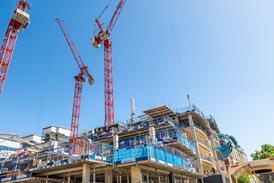INNOVATION — The government wants developers to build on brownfield. So what’s it doing to encourage them?
With proposals for a planning gain supplement on the table and statistics showing the potential for 980,000 homes to be built on brownfield sites, the spotlight is once again on how to make brownfield development more attractive.
The statistic that 74% of all new development has been on previously developed land somewhat distorts the picture and shouldn’t be taken as firm evidence that current incentives are having the desired effect. The reality is that the pool of viable brownfield sites will diminish and attention will shift to the more marginal and hard core derelict sites. As a result incentives will take on greater significance. So, how is the government helping?
One option being considered is to tax planning gain on brownfield sites at a lower rate than greenfield. While potentially self-defeating insofar as it would reduce the amount of funds raised to pay for infrastructure to these sites, there is at least recognition that some form of brownfield concession will be required.
The brownfield development industry should also be encouraged by the news that the Land Remediation Scheme, a facility that allows public authorities to gap-fund remediation, has been given state aid approval for an extension until 2013. This is largely an unused scheme due mainly to the fact that there are no specific allocated funds. But with the government’s comprehensive spending review due in July 2007 we may yet see specific funds allocated to this.
That leaves 150% land remediation relief as the only certain form of incentive. The DCLG report reviewing the effectiveness of the relief concluded that most development sites benefiting from it would have proceeded irrespective of its availability and as such it represents poor value for money. Clearly the chancellor can withdraw a tax relief at any point but as the relief only cost the Treasury £18m in 2003/2004, there would be little motivation for its withdrawal, especially at a time when its full impact is yet to be assessed.
So what impact is the relief having? The answer depends on both circumstance and approach. Polluters and public bodies carry out major remediation programmes and yet are unable to benefit directly from the relief. At the other end developers specialising in selling remediated sites can make significant additional post-tax returns as a direct consequence of the relief. Either way the position can often be improved through a more pro-active approach that considers the interaction of the parties involved in the site ownership and development structure, as well as the way the actual claim is prepared.
The DCLG report did not consider entitlement and eligibility issues and so it is hardly surprising misconceptions persist. The most common misconception appears to be that all purchase price reductions that reflect the condition of the site amount to a subsidy in the hands of the purchaser, thereby preventing them from claiming the relief.
The extent of eligible expenditure claimed also varies and it would be worth taking specialist advice to ensure that the maximum amount is claimed. The scope of a claim can go beyond obvious hotspot and asbestos removal costs and can in some circumstances extend to additional foundation costs created as a consequence of the remediation as well as all associated site costs and professional fees.
Clearly, the impact the tax relief has on development viability will depend on the extent of remediation as a proportion of total cost. However, the fact remains that this relief is the one mechanism that enables a developer to reduce their tax liability and its potential significance should not be overlooked.
Source
RegenerateLive
Postscript
By Ben de Waal, partner at Davis Langdon Crosher & James
























No comments yet